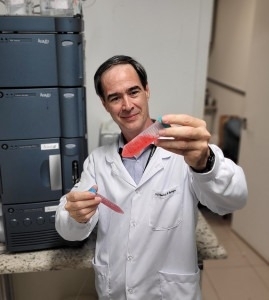


Resin applied to purification of compound can be reused in eight different cycles without loss of effectiveness (Maurício Ariel Rostagno, professor at FCA-UNICAMP and one of the inventors of the technology/photo: INOVA UNICAMP)
Published on 06/12/2023
Agência FAPESP* – Organic colorants can be substitutes for synthetic versions and are in fact widely used in several industries, including textile and food manufacturing. However, a natural colorant may be unstable depending on the conditions in the application medium, especially light and temperature. Stabilization is a challenge, often requiring more expenditure of energy and organic resources, with adverse environmental impacts.
To solve this problem, researchers at the State University of Campinas’s Schools of Applied Sciences (FCA-UNICAMP) and Food Engineering (FEA-UNICAMP), in São Paulo state, Brazil, developed a faster and more natural route for the production of colorants from grape pomace, the anthocyanin-containing pulpy residue remaining after the fruit has been crushed to extract its juice. Pomace is considered waste by wineries.
Anthocyanins are water-soluble pigments belonging to the flavonoid family. They are phenolic compounds found in all plants and responsible for the shades of red, blue and purple seen in flowers, fruit, leaves, stalks and roots.
Maurício Ariel Rostagno, a professor at FCA-UNICAMP and one of the inventors of the technology, pointed out that the resin used in the purification process can be reused in eight different cycles without losing its effectiveness.
“This is healthy for the environment and for people. Synthetic colorants are highly allergenic and a health hazard generally. Manufacturers are now facing a great deal of scrutiny on these grounds, so there’s plenty of demand for our technology. We set out to develop ‘greener’ and more efficient ways to purify these compounds, with less environmental impact and lower costs,” Rostagno said.
The novel technology is the fruit of three projects supported by FAPESP (18/14582-5, 19/13496-0 and 20/08421-9). Patent applications have been filed with INPI, the Brazilian patent office, and internationally by INOVA, UNICAMP’s innovation agency.
Results of the studies are described in articles published in the journals Green Chemistry and Food Chemistry.
According to the authors of the articles, the process is fast, does not use highly volatile organic solvents, and yields more stable results than pigments obtained by ethanol- or water-based extraction. In addition, the process does not require sophisticated equipment or specialized labor.
“An important aspect of this process is stability. We achieved high yield and purity, while at the same time increasing the stability of the compounds to a higher level than in conventional processes. Solvent recovery exceeded 90%,” Rostango said.
Bright colors
Natural colorants reach 90% purity in the novel process, guaranteeing stable bright hues. The solvents also permit the use of colorants at high temperatures, extending their potential industrial applications.
Other benefits of the novel technology highlighted by Rostagno are the recycling of grape pomace, typically thrown away as waste by farmers, as raw material for eutectic solvents, contributing to more efficient use of natural resources.
“Retrieving these substances, which would otherwise be disposed of or composted, adds value for grape growers,” he said.
The article “Combining eutectic solvents and pressurized liquid extraction coupled in-line with solid-phase extraction to recover, purify and stabilize anthocyanins from Brazilian berry waste” is at: pubs.rsc.org/en/content/articlelanding/2023/gc/d2gc04347e.
The article “Combining eutectic solvents and food-grade silica to recover and stabilize anthocyanins from grape pomace” is at: www.sciencedirect.com/science/article/abs/pii/S0308814622030552.
* With information from INOVA UNICAMP.
Source: https://agencia.fapesp.br/41619